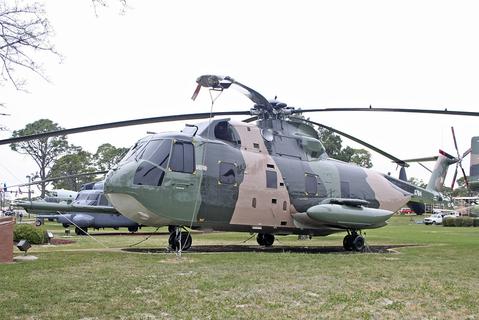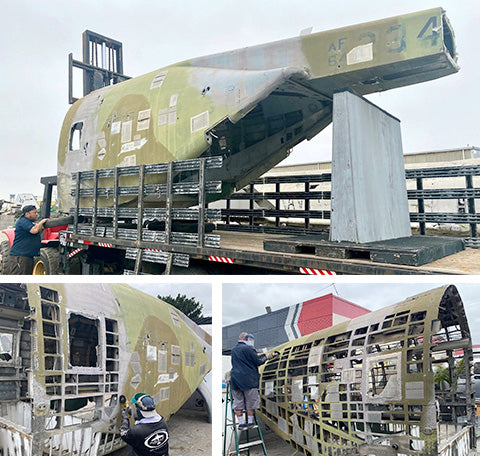
- by Dianna Lopez
Sikorsky H-3: Search and Rescue At Its Best
- by Dianna Lopez
This site uses cookies for better user experience and analytics.

The Sikorsky S-61 / H-3 was a heavy-lift helicopter active during the Southeast Asia War years and beyond. It was uniquely equipped to perform search and rescue missions with its armor and armament, pioneering in-flight fueling system, and more - everything needed to put its crew in harm’s way to rescue fellow downed airmen and ensure that our brave soldiers were not left behind. Read about the variations of this amazing machine and find out how you can get your own Sikorsky H-3 PlaneTags.

Sikorsky Aircraft is an aircraft manufacturer first established in 1923 by Russian-American aviator Igor Sikorsky as Sikorsky Aero Engineering Corporation. Although the company changed names a few times before eventually being bought by Lockheed Martin, the Sikorsky name is a respected manufacturer of aircraft, mainly focusing on helicopters. Sikorsky produced many notable helicopters such as the UH-60 Black Hawk, SH-60 Seahawk, and every U.S. Presidential helicopter since 1957. The world’s first production helicopter, the Sikorsky R-4, was produced from 1942 to 1944.

Photo of 65-12784, Used by permission from Malcolm Nason
The H-3 is a twin engine, heavy lift helicopter, used mainly as a combat search and rescue aircraft by the U.S. Air Force. This craft, with some variations, is also known as CH-3C/E, HH-3E Jolly Green Giant, and the U.S. Coast Guard’s HH-3F Pelican. Only a handful of HH-3Es were manufactured, but several CH-3Es (non combat search and rescue variant) were converted to HH-3Es. It was based on the earlier S-61/H-3 helicopter design, but with improvements to its engines, as well as protective armor, self sealing tanks, water landing capability, a high speed hoist, armaments, and external tanks that could be jettisoned. This feature along with its retractable inflight refueling probe made it perfect for long range CSAR missions.
The first USAF Jolly Green Giants were sent to Da Nang Air Base in South Vietnam and Udorn Air Base in Thailand during the Southeast Asia War. They were painted green and brown camouflage and could be deployed to North Vietnam immediately and perform long hours of grueling search and rescue missions in support of the U.S. troops. It carried two 7.62 mm M-60 machine guns and was well honed for Combat Search and Rescue. Its airframe became the basis for future CSAR helicopters, with many innovations still in place today on modern military helicopters. It was later used in CSAR missions in Operation Desert Storm, and to retrieve aerospace equipment in support of the Space Shuttle program.

CSAR missions were introduced during World War II and were unique in that their pilots and crew were dispatched right into the fray, flying right into the heart of danger to rescue downed airmen, under fire and sometimes at the cost of their own lives. The H-3s flew in pairs, one in high-bird position and one in low-bird, flying at much lower altitudes to pick up the downed airmen, usually with a group of heavily armed Douglas A-1 Skyraiders as protection and Hercules for in-flight refueling. If the low-bird aircraft was damaged it could return to base, leaving the high-bird to continue the mission. The amount of funding and resources that were placed into developing such a robust CSAR program is a testament to the dedication and priority the US placed on recovering their downed airmen.
Our helicopter s/n 64-14234, was manufactured as c/n 61-537 and delivered to USAF August 9, 1965 as a CH-3C. It was transferred to the 507 Tactical Air Command Wing / 703 Tactical Air Support Squadron at Shaw AFB, near Sumter, South Carolina where it served between August 2nd, 1970 to January 1, 1986. Sometime during this time, it was converted for combat search and rescue. It was retired and sent to Aircraft Maintenance And Regeneration Center (AMARC) as 44005 on February 8, 1990 for storage. Its fuselage ended up at the Yanks Air Museum, in Chino, California, to be used for parts for the museum’s Sikorsky CH‑3C Sea King.
While our aircraft has conflicting designations and its exact history is unclear, based on conversations with experts, Yanks Air Museum, and extensive research, MotoArt has determined to use the H-3 designation. These conflicts could be a simple matter of mishandled paperwork rather than the actual modifications to the aircraft. Either way this Sikorsky helicopter was born in 1964 and now lives on as a piece of aviation history.

Yanks Air Museum is a museum and a non-profit 501 (c)(3) organization, located in Chino, California, dedicated to the restoration and preservation of American aircraft and artifacts. Their museum houses one of the largest aircraft collections and features many vintage aircraft, which have been painstakingly restored to airworthy status. Many of their planes are legends, including many that are the only remaining specimens left. Their incredible collection began in 1973 and since then has grown from one Beech Staggerwing to over 200 aircraft. They continue to restore and preserve incredible aircraft and are also working on expanding to an additional location near Monterrey, California.


MotoArt owner Dave Hall was delighted to receive the fuselage section of a Sikorsky Jolly Green Giant and have the opportunity to preserve a part of an aircraft with such an important mission. “What makes this launch of the Jolly Green exciting to us, is not only the incredible chance to work with the H-3 Sikorsky, but also the opportunity to work with Yanks Air Museum. Yanks is an amazing North American collection of aviation history. A truly astonishing museum to walk through. It’s an honor to have the backing of Yanks Air Museum for the PlaneTags.”



Our newest PlaneTags are numbered to 3,000 and come in three color variations: gray, green, and a weathered patina. They are expected to sell out quickly, so make sure to get one to add to your collection or to give as an cherished Veterans Day gift or gift for your favorite pilot.

Add these other helicopter PlaneTags to your collection before they are gone:
F-14 Tomcat Coasters: A Legendary Fighter Reimagined for Your Home
Few aircraft define an era quite like the Grumman F-14 Tomcat. Sleek, powerful, and unmistakably iconic, the Tomcat was the Navy’s premier fleet defense fighter for more than three decades. From Cold War missions to pop culture stardom, the F-14 remains one of the most recognizable and beloved aircraft ever built. Today, MotoArt is proud to introduce the F-14 Tomcat Coaster Set, created from authentic F-14 aircraft material.
PR-AJB: The Story of an Azul Airbus A320 With a Global Journey
Every airplane has a story, and some travel farther than others before their flying days are over. PR-AJB was one of those well-traveled aircraft. This Airbus A320 started its life flying British families on long-awaited holidays, then later crossed the Atlantic to join the growing fleet of Azul Linhas Aéreas Brasileiras. Over nearly nineteen years it picked up new registrations, new paint, new routes and a new home, carrying thousands of passengers along the way.
Its journey reflects how widely the A320 family has spread around the world and how easily these aircraft adapt to whatever their next chapter requires. PR-AJB also arrived at Azul during an important period of expansion as the airline worked to connect more cities across Brazil. In this blog we will explore where the aircraft came from, what it did during its short time with Azul, and how it eventually came to rest in Florida. We will also share how MotoArt recovered material from the retired airframe and created PlaneTags so its story can continue in a new way.
Fairchild C-82 Packet: The Forgotten Twin-Boom
Before the Flying Boxcar became a military workhorse, Fairchild’s engineers built an ambitious twin-boom transport that paved the way for it. The Fairchild C-82 Packet was a postwar cargo aircraft that promised big things but struggled to live up to them. Although it served for only a few short years, it played an important role in shaping the aircraft that would follow. Today, the legacy of one particular Packet, serial number 44-22991, lives on through MotoArt PlaneTags, preserved from the legendary Soplata Collection.


Share:
Aeroflot MD-11F: Connecting Cargo With The World
Vietnam Airlines A321: Soaring with beauty and enlightenment